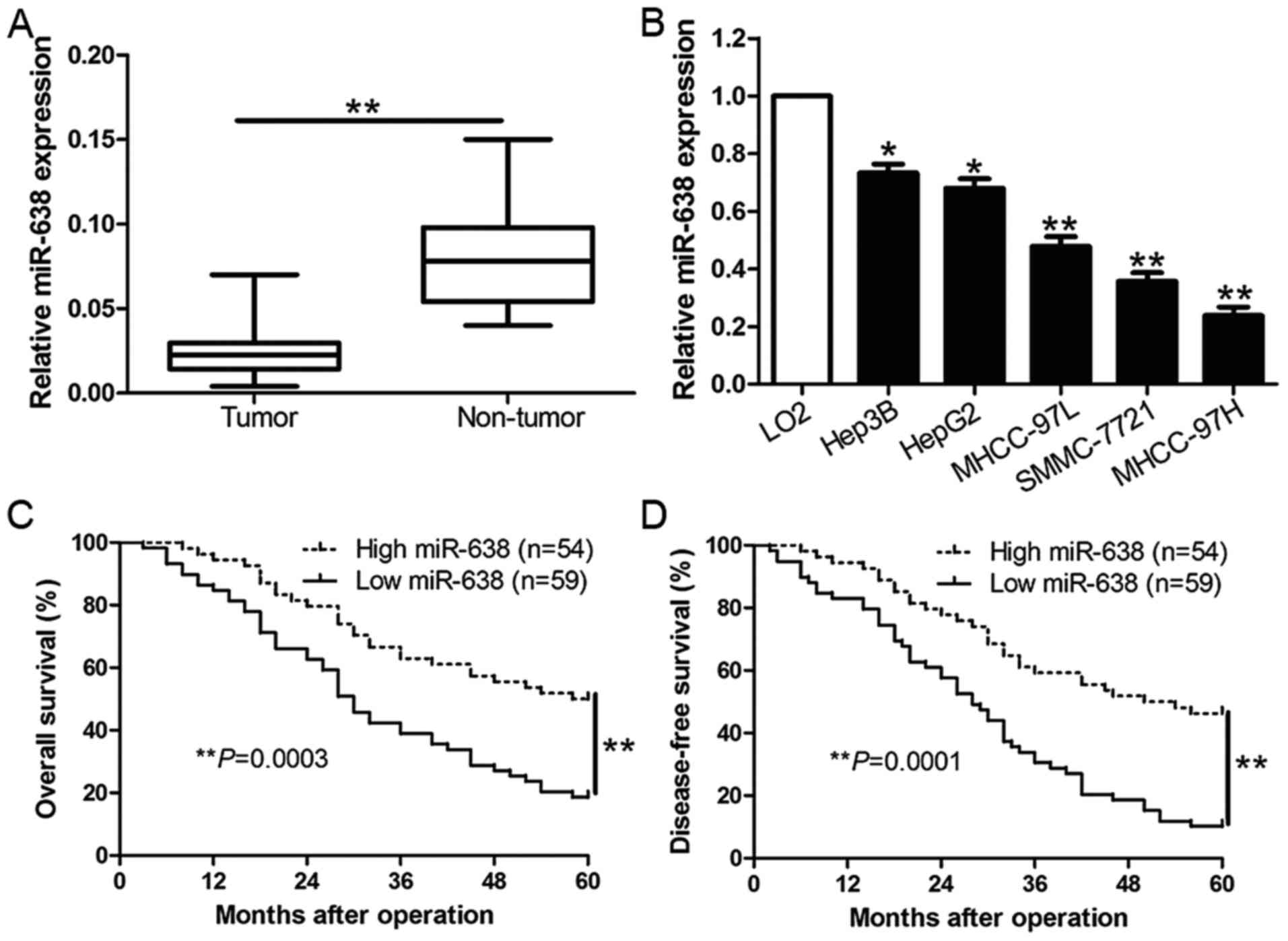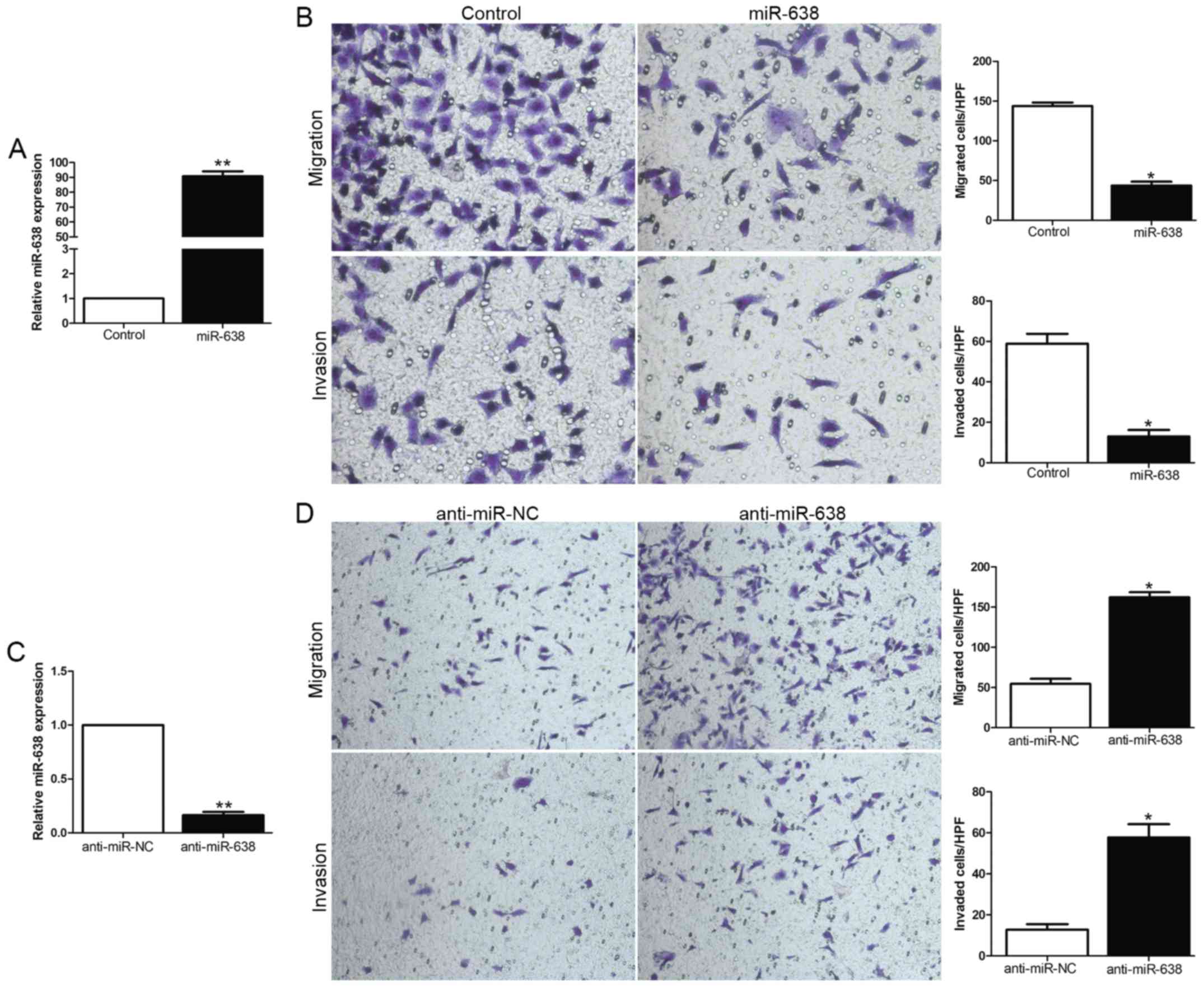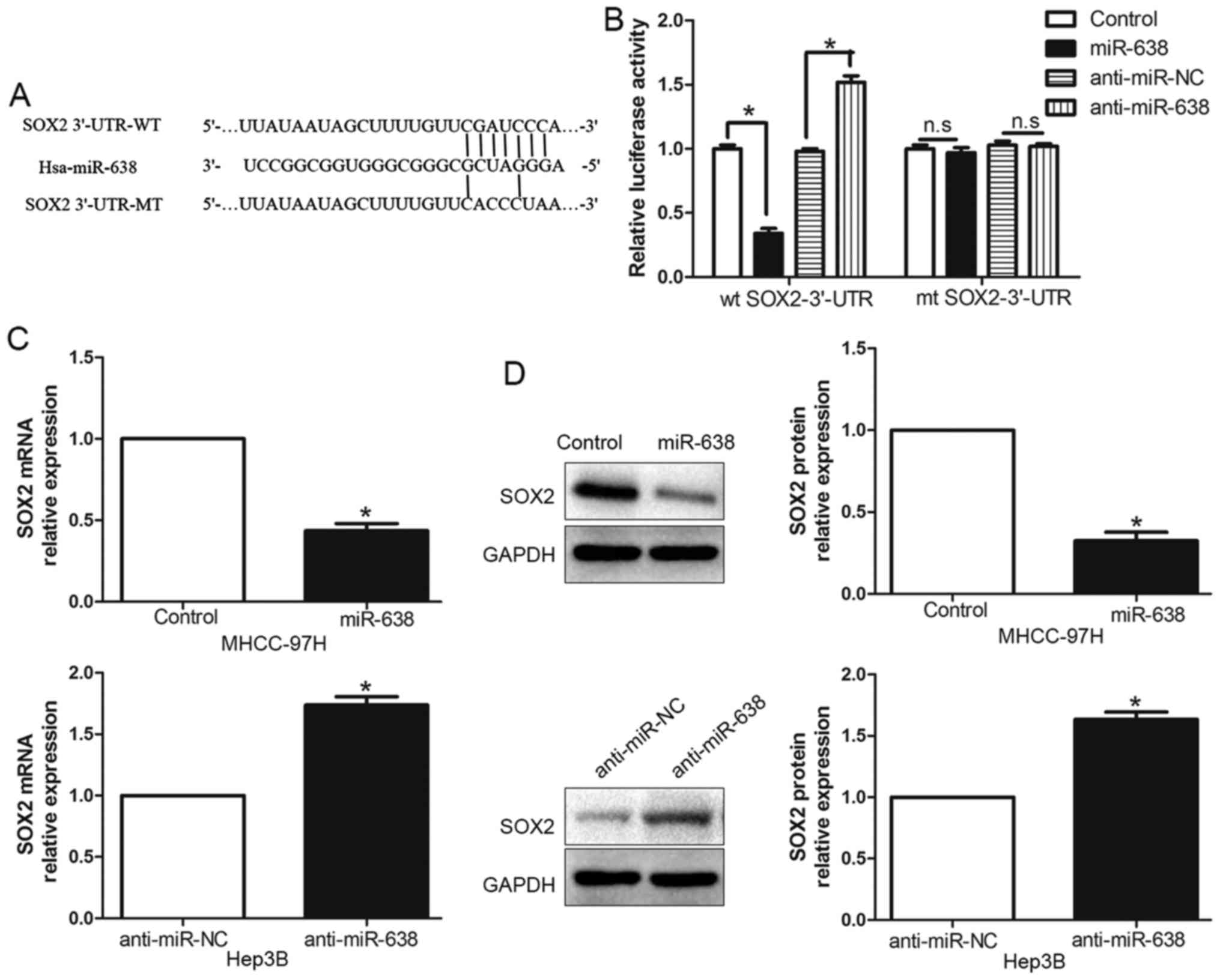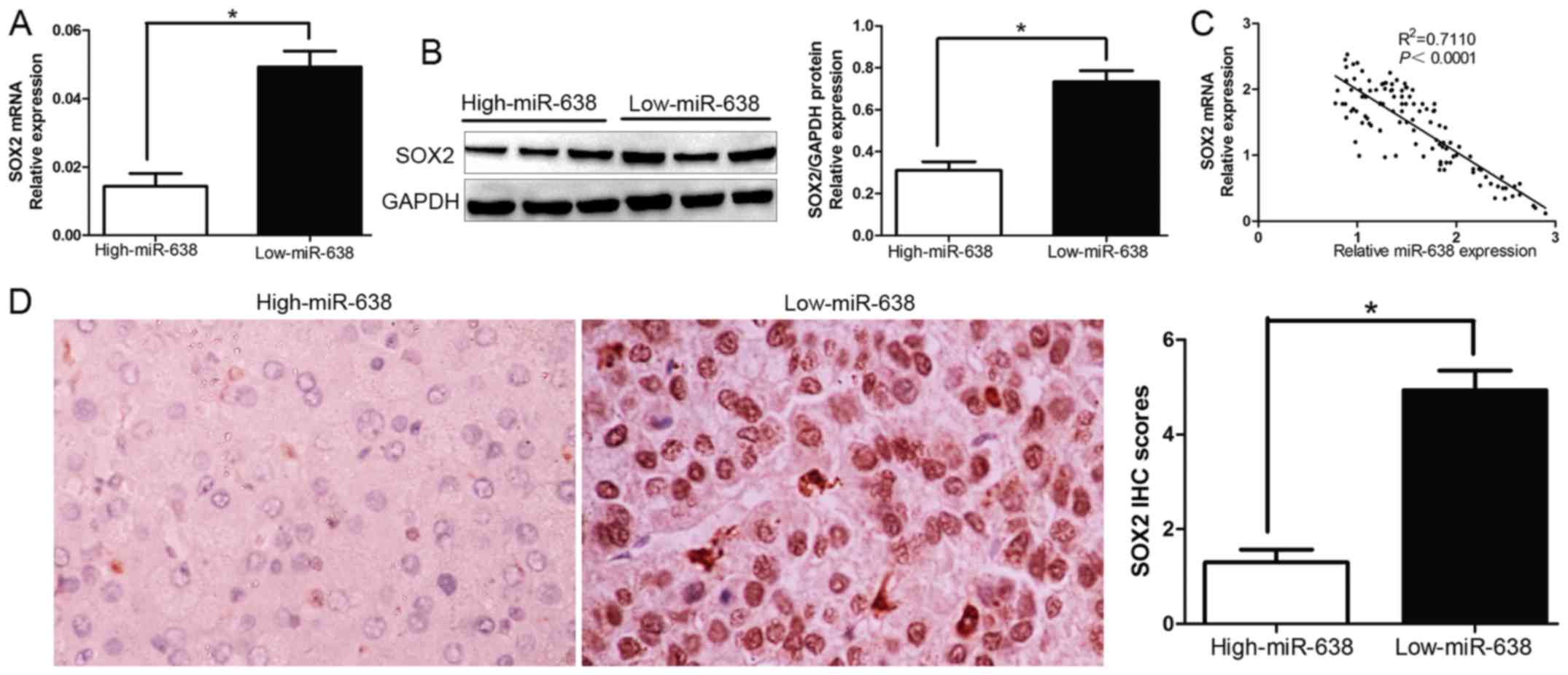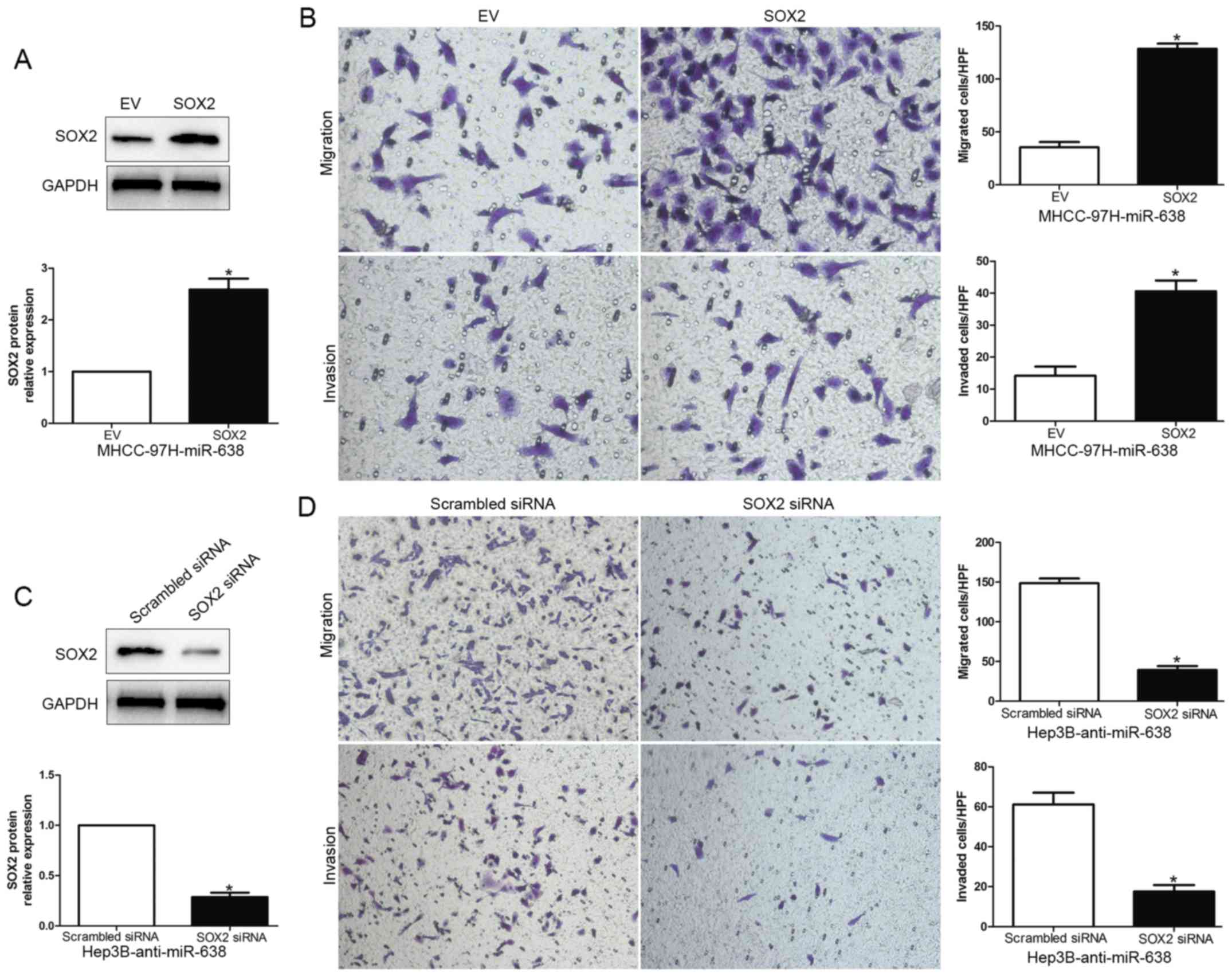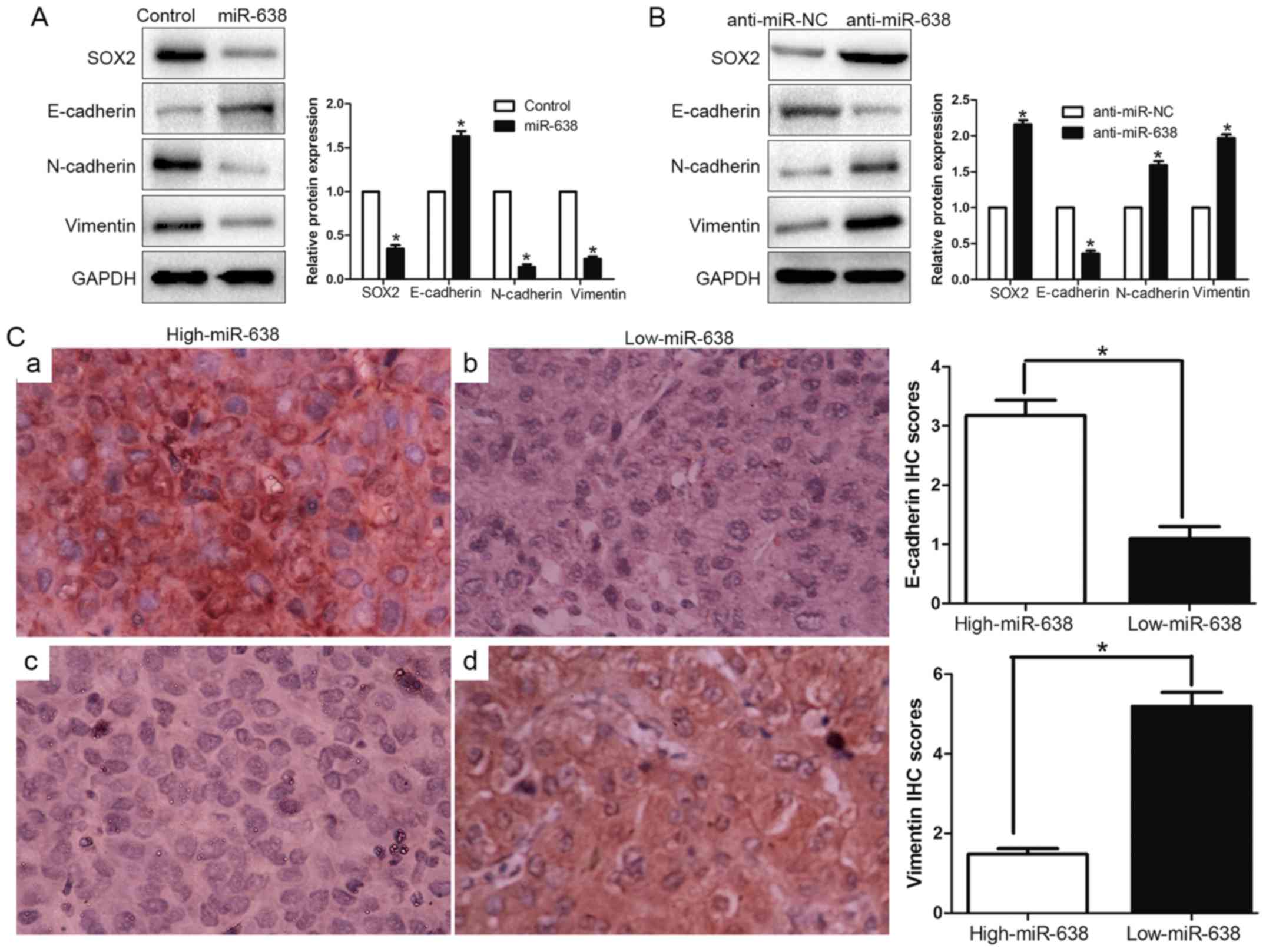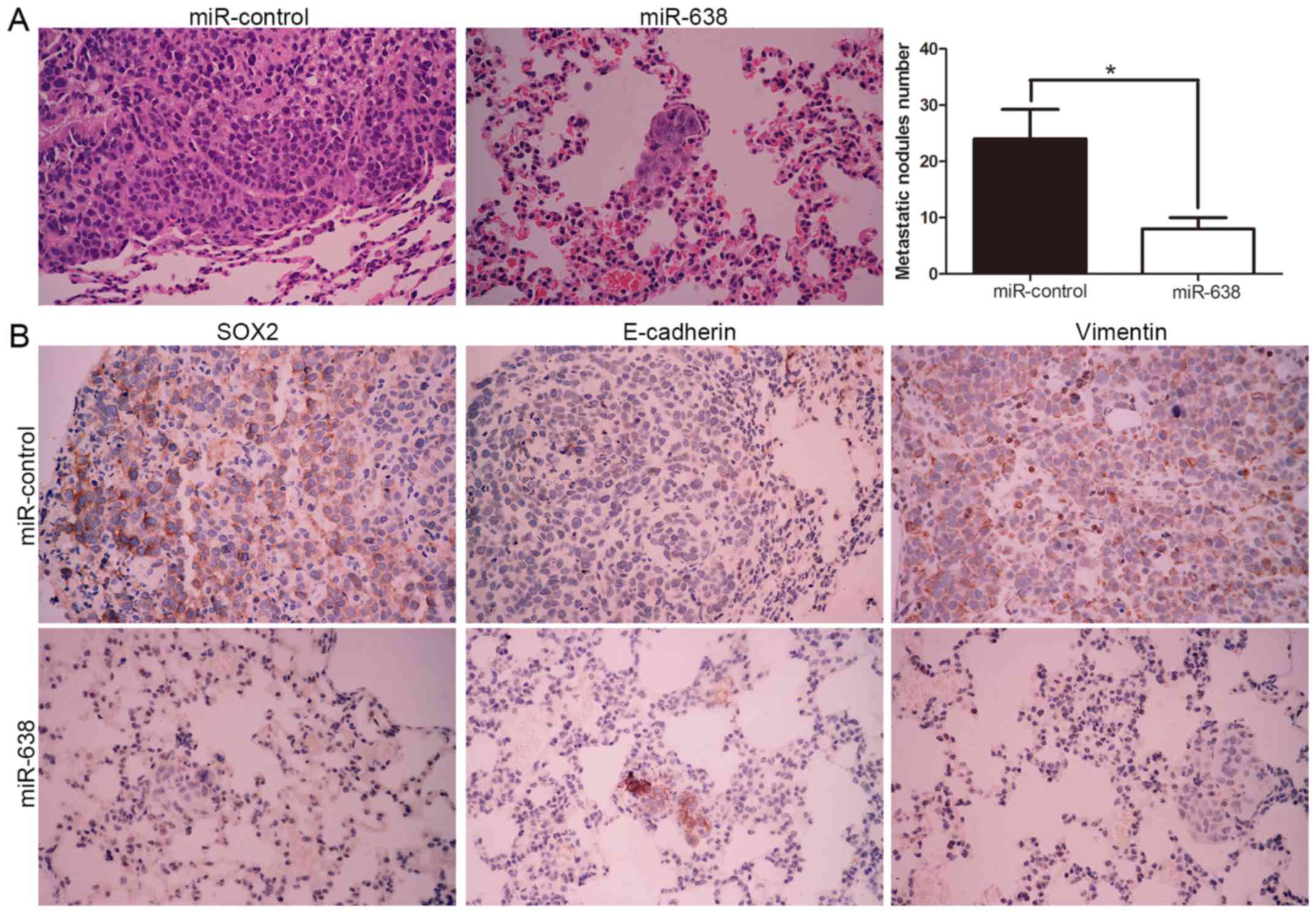Loss of miR-638 promotes invasion and epithelial-mesenchymal transition by targeting SOX2 in hepatocellular carcinoma
- Authors:
- Published online on: November 23, 2016 https://doi.org/10.3892/or.2016.5273
- Pages: 323-332
Abstract
Introduction
MicroRNAs (miRNAs) are an endogenous group of small non-coding single-stranded RNAs that play critical roles in different biological processes through negatively regulating various genes at posttranscriptional level, predominantly by interacting with the 3′-untranslated regions (3′UTR) by targeting corresponding messenger RNAs (mRNAs) (1,2). Increasing evidence has demonstrated that aberrant miRNAs are implicated in cellular processes, including cell cycle, differentiation, proliferation, apoptosis and tumorigenesis (3). Previous studies have identified the pivotal role in human tumors and indicate that abnormal miRNAs are involved in the initiation, progression, migration and invasion of human cancers by modulating the target mRNAs expression of oncogenes or suppressor genes, including hepatocellular carcinoma (HCC) (4,5). Hence, miRNAs have been regarded as a novel promising indicator and attractive therapeutic strategy for HCC patients.
Recently, mounting studies demonstrated that miR-638 function as a critical regulator of tumorigenesis, development and progression. miR-638 played an important role in a wide range of human cancers (6–10). For instance, miR-638 functions as suppressor to inhibit cell proliferation, invasion and regulate cell cycle by targeting tetraspanin 1 in human colorectal carcinoma (CRC) and a low expression of miR-638 is associated with poor survival prognosis of CRC patients (11). miR-638 suppresses gastric cancer cell proliferation by targeting specificity protein 2 (Sp2) with influence on the expression of cyclin D1 (12). However, miR-638 supports melanoma metastasis and progression and suppresses p53-mediated apoptosis pathways and autophagy by targeting the TP53INP2 transcription (13). miR-638 is overexpressed in human vascular smooth muscle cells and inhibits PDGF-BB-induced cell proliferation and migration through targeting orphan nuclear receptor NOR1 (14). Therefore, the functional significance of miR-638 in cancer progression seem to be cancer-type specific. Recently, miR-638 was reported to be downregulated in HCC specimens and to inhibit angiogenesis and growth of HCC by targeting VEGF (15). However, the clinical significance of miR-638 and the underlying mechanisms implicated in the initiation and development of HCC remain to be investigated.
Epithelial to mesenchymal transition (EMT) has been proposed to have a critical role in the invasion and metastasis of different cancers through transformation of adherent and polarized epithelial cells interacting with the basement membrane by its basal surface, into invasive and motile mesenchymal cells (16,17). It is characterized by loss of epithelial traits, such as E-cadherin repression, accompanied by gain of mesenchymal features, such as increased N-cadherin and vimentin (18). Accumulated evidence revealed that EMT plays an important role in HCC invasion and metastasis. Recent studies have demonstrated that miRNAs are involved in the EMT process in HCC development (8,19). However, the association between miR-638 and EMT in HCC has remained elusive.
In this study, we investigated the critical role of miR-638 in HCC progression. Our results revealed that miR-638 was downregulated in the HCC and the reduced miR-638 was associated with adverse prognostic characteristics and poor 5-year survival of HCC patients. We identified that miR-638 could regulate the migration and invasion of HCC by targeting SOX2 in vitro. Furthermore, miR-638 induced EMT phenotype in vitro and in vivo. These data identify the underlying mechanism by which miR-638 inhibits migration and invasion of HCC, and miR-638 is regarded as a novel prognostic biomarker for HCC patients.
Materials and methods
Clinical tissues and cell cultures
The HCC samples and matched adjacent tissues from 113 patients who underwent radical surgical resection at the Second Affiliated Hospital of Xi'an Jiaotong University from March 2007 to June 2009 were studied. Tissues were immediately snap-frozen and stored at −80°C for RNA extraction. None of the patients had received any perioperative chemo- or radiotherapy. The patients signed an informed consent form, and this research was approved by the Ethics Committee of Xi'an Jiaotong University.
The human HCC cell lines Hep3B, HepG2, MHCC-97L, SMMC-7721, MHCC-97H and the normal human immortalized hepatocyte LO2 cells were obtained from the Institute of Biochemistry and Cell Biology (Chinese Academy of Sciences, Shanghai, China) and were cultured in Dulbecco's modified Eagle's medium (DMEM, Hyclone, Logan, UT, USA) containing 10% FBS (Invitrogen, Carlsbad, CA, USA), 1% penicillin-streptomycin (Sigma, St. Louis, MO, USA). All the cells were incubated in a humidified atmosphere at 37°C with 5% CO2.
RNA extraction and quantitative real-time polymerase chain reaction (qRT-PCR)
Total RNA from HCC tissues and cells was extracted using TRIzol reagent (Invitrogen) according to the manufacturer's protocol. cDNA was reverse-transcribed from 1 µg total RNA using a Reverse Transcription kit (Takara Biochemicals, Tokyo, Japan). cDNA was then amplified with a SYBR® Premix Ex Taq™ II (Perfect Real-Time) kit (Takara Biochemicals). The gene expression levels were calculated using the ∆∆Ct method with U6 or GAPDH as an internal control. Hsa-miR-638 primer (HmiRQP0748), snRNA U6 qPCR Primer (HmiRQP9001), SOX2 (HQP017628) and GAPDH (HQP006940) were purchased from Genecopoeia (Guangzhou, China).
Western blotting
The whole proteins from cultured cells and tissues was quantified with BCA Protein Assay kit (Thermo Scientific, Rockford, IL, USA), and an equal amount of 40 µg protein was separated by 10% SDS-PAGE and then transferred onto PVDF membranes (Millipore, Billerica, MA, USA). The membranes were blocked with 5% nonfat milk in TBST for 2 h at room temperature and incubated overnight with respective primary antibodies (1:1000, Cell Signaling Technology, Inc.) at 4°C. Then the membranes were washed three times by TBST and incubated with appropriate HRP-conjugated secondary antibody for 2 h at room temperature (ZSGB-BIO, Beijing, China). Detection was performed by enhanced chemiluminescence kit (Amersham, Little Chalfont, UK).
Cell transfection
Hsa-miR-638 precursor was purchased from Songon Tech (Beijing, China) and inserted into pcDNA6.2-GW/EmGFPmiR vector (named miR-638) according to the manufacturer's instructions. miR-638 inhibitor (HmiR-AN0748) and the negative control (CmiR-AN0001-AM04) were obtained from Genecopoeia. The SOX2 overexpression plasmid and specific siRNA against SOX2 (sense, 5′-GGAAUGGACCUUGUAUAGAUC-3′; anti-sense, 5′-UCUAUACAAGGUCCAUUCCCC-3′) and a scramble siRNA were synthesized by Sangon Biotech Co., Ltd. (Shanghai, China). Cells were transfected with the above vectors using Lipofectamine 2000 Reagent (Invitrogen Life Technologies) in accordance with the manufacturer's protocol.
Immunohistochemical staining
Immunohistochemical staining was performed on 4 µm sections of paraffin-embedded tissues to detect the protein expression. The corresponding antibody (1:300, Cell Signaling Technology, Inc.) was applied as the primary antibody by a streptavidin peroxidase-conjugated (SP-IHC) method. The staining results were semi-quantitatively evaluated by the multiplicity of staining intensity and the percentage of positive staining cells. The percentage of positive cells was graded: 0 for <5%; 1 for 6–25%; 2 for 26–50%; 3 for 51–75% and 4 for >75%. Staining intensity was assessed by four degrees: 0, negative; 1, weak; 2, moderate; and 3, strong. Each section was assayed in ten independent high magnification (×400) fields to obtain the average scores.
Cell migration and invasion assays
Matrigel-uncoated and - coated Transwell inserts (8 µm pore size; Millipore) were used to evaluate cell migration and invasion. Briefly, 5×104 transfected cells were suspended in 200 µl serum free DMEM medium in the upper chamber, and 750 µl DMEM medium containing 10% FBS was placed in the lower chamber. After 24 h of incubation, cells were fixed in 4% paraformaldehyde for 20 min and stained with 0.1% crystal violet dye for 15 min. The cells on the inner layer were softly removed with a cotton swab and counted at five randomly selected views, and the average cell number per view was calculated.
Dual-luciferasee reporter gene assay
The 3′-UTR sequence of SOX2 was predicted to interact with miR-638, together with a corresponding mutated sequence within the predicted target sites, were synthesized and inserted into the pRL-TK control vector (Promega, Madison, WI, USA) called wt-SOX2 3′-UTR and mt-SOX2 3′-UTR. Subsequently, MHCC-97H cells that were plated into a 24-well plate and were transfected with 120 ng miR-638 inhibitor or negative control. Cells were co-transfected with 30 ng of the wild-type or mutant 3′-UTR of SOX2 vector using Lipofectamine 2000 reagent (Invitrogen). After 48 h, cells were harvested and measured according to the manufacturer's instructions (Dual-Luciferase Assay System; Promega). pRL-TK expressing Renilla luciferase was co-transfected as an internal control to correct the differences in both transfection and harvest efficiencies.
In vivo metastasis assay
Female BALB/c nude mice (4–6 week-old) (Centre of Laboratory Animals, The Medical College of Xi'an Jiaotong University, Xi'an, China) were randomized into two groups (n=5), and either MHCC-97H-miR-638 or MHCC-97H-miR-control cells (1×106) were injected into the tail veins for the establishment of a pulmonary metastatic model. Mice were sacrificed 10 weeks post-injection and examined microscopically by H&E staining for the development of lung metastatic foci. Animals were housed in cages under standard conditions. All in vivo protocols were approved by the Institutional Animal Care and Use Committee of Xi'an Jiaotong University.
Statistical analysis
Data are presented as the mean ± SD and performed at least three independent replicates. SPSS software, 16.0 (SPSS, Inc, Chicago, IL, USA) and Graphpad Prism 6.0 (GraphPad Software, Inc., La Jolla, CA, USA) were used for a two-tailed Student's t-test, Pearson's correlation analysis, Kaplan-Meier method and the log-rank test to evaluate the statistical significance. Differences were defined as P<0.05.
Results
Clinical significance of reduced miR-638 in HCC samples
To assess the expression level of miR-638 in HCC, we performed qRT-PCR to determine the expression of miR-638 in 113 pairs of HCC tissues and matched adjacent non-tumor tissues. As shown in Fig. 1A, the mean level of miR-638 expression in HCC tissues was obviously downregulated when compared to the matched non-tumor tissues (P<0.01, Fig. 1A). Moreover, similar result was found in HCC cell lines. The data revealed that miR-638 was remarkably reduced in a panel of HCC cell lines than the normal hepatocyte cell line LO2 (P<0.05, Fig. 1B). To further evaluate the role of miR-638 in the progression of HCC, we analyzed the relationship between miR-638 expression and the clinical characteristics and prognosis of HCC patients. With the median level of miR-638 as the cut-off, the low expression of miR-638 was prominently associated with high Edmondson-Steiner grading (P=0.002), venous infiltration (P=0.004) and tumor-node-metastasis (TNM) stage (P=0.007) (Table I). Furthermore, the low expression of miR-638 was closely correlated with poor overall survival (OS) (P=0.0003, Fig. 1C) and disease-free survival (DFS) (P=0.0001, Fig. 1D) in HCC patients. In addition, miR-638 expression was an independent factor for predicting both 5-year OS and DFS of HCC patients (P=0.016 and 0.010, respectively, Table II). Taken together, these data demonstrate that miR-638 showed reduced expression in HCC and inversely associated with clinical characters and prognosis of HCC patients, which suggest miR-638 was involved in the development of HCC.
miR-638 represses migration and invasion of HCC cells in vitro
We focused on the functional effects of miR-638 in HCC cells, gain- and loss-of-function assays were performed through transfection of miR-638 or anti-miR-638 expression vector into HCC cell lines with moderate miR-638 expression level. The transfection efficiency was confirmed by using qRT-PCR (Fig. 2A and C). As measured by Matrigel-coated (for invasion) and -uncoated (for migration) Transwell assays, ectopic expression of miR-638 significantly inhibited the migration and invasion of MHCC-97H cells (P<0.05, Fig. 2B), whereas the silencing of miR-638 expression obviously enhanced the number of migrated and invaded Hep3B cells (P<0.05, Fig. 2D). In conclusion, these data suggested that miR-638 could inhibit HCC cell migration and invasion.
miR-638 directly inhibits SOX2 expression by interacting with its 3′-UTR
To elucidate the underlying mechanism of miR-638-mediated suppression of cell migration and invasion, we used TargetScan and miRanda algorithms to search for putative protein-coding gene targets of miR-638. Bioinformatics software indicated that SOX2 3′-UTR binds to miR-638 with high score (Fig. 3A). Moreover, previous studies have confirmed that miR-638 could modulate SOX2 expression by directly binding its 3′-UTR (8,19). To verify this, we generated a luciferase reporter plasmid which carried the mutated binding site of miR-638 in the SOX2 3′-UTR and found that miR-638 overexpression significantly inhibited the luciferase activity of SOX2 containing a wild-type (wt) 3′-UTR but did not suppress the activity of SOX2 with a mutant (mt) 3′-UTR (P<0.05, Fig. 3B). On the contrary, miR-638 suppression increased the luciferase activity of wt SOX2 3′-UTR (P<0.05, Fig. 3B) but had no effect on mt SOX2 3′-UTR constructs. Subsequently, we examined the response to the alteration of miR-638 expression in vitro. Our data showed the negative regulatory effect of miR-638 on SOX2 both in MHCC-97H and Hep3B cell lines. Overexpression of miR-638 inhibited SOX2 expression, moreover, downregulated miR-638 could increase SOX2 expression both in mRNA (P<0.05, Fig. 3C) and protein (P<0.05, Fig. 3D) level. These data indicated that miR-638 could modulate SOX2 expression by directly binding its 3′-UTR in HCC cells.
SOX2 levels are negatively correlated with miR-638 expression
To further evaluate the relationship between SOX2 and miR-638 in HCC tissues, we investigated the SOX2 mRNA and protein expression in different miR-638 levels. As expected, we demonstrated that both SOX2 mRNA and protein expression level in high miR-638 group were significantly lower compared with those in low miR-638 group in HCC (P<0.05, Fig. 4A and B). Furthermore, the results showed that the mRNA level of SOX2 in the HCC tissues was inversely correlated with miR-638 expression (R2=0.711, P<0.0001, Fig. 4C). Consistently, as assessed by IHC assay, SOX2 protein expression in miR-638 high-expressing tumors was obviously lower than miR-638 low-expressing tumors (P<0.05, Fig. 4D), which was similar with previous studies. The data suggested that the increased SOX2 expression in HCC was caused by miR-638 downregulation. Taken together, these results indicated that SOX2 was a target gene of miR-638 in HCC.
Alterations of SOX2 expression levels influences the effects of miR-638 on HCC cells
To further determine that SOX2 is a functional target of miR-638, we overexpressed SOX2 by the transfecting SOX2 expression plasmid in MHCC-97H-miR-638 cells, or silenced SOX2 by SOX2 siRNA in Hep3B-anti-miR-638 cells (P<0.05, Fig. 5A and C). As expected, restoration of SOX2 expression partially abrogated the migration and invasion suppressive effect of miR-638 on MHCC-97H cells (P<0.05, Fig. 5B). Additionally, SOX2 siRNA reversed the effects of miR-638 inhibition on Hep3B cells (P<0.05, Fig. 5D). Taken together, these experimental data suggest that the migration and invasion effect of HCC are regulated by miR-638, and these miR-638 functions at least partially rely on the suppression of SOX2 expression.
Loss of miR-638 promotes a mesenchymal-like transition in HCC cells
EMT has been identified as a pivotal role in the invasion of diverse cancer cells by the transformation of polarized and adherent epithelial cells into invasive mesenchymal cells. To confirm whether miR-638 was implicated in the EMT process, we examined the epithelial marker (E-cadherin) and mesenchymal marker (N-cadherin and vimentin) through western blotting. We found upregulated miR-638 increased the epithelial marker E-cadherin and decreased N-cadherin and vimentin expression (P<0.05, Fig. 6A). In contrast, inhibition of miR-638 suppressed E-cadherin expression and induced N-cadherin and vimentin expression (P<0.05, Fig. 6B). Furthermore, we determined the correlation between miR-638 expression and E-cadherin expression and vimentin expression in HCC tissues. We found that the E-cadherin expression in high miR-638 group was higher than that in low miR-638 group. Conversely, the expression level of vimentin in the high miR-638 group was significantly lower than that in low miR-638 group (P<0.05, Fig. 6C). Taken together, these data indicated that miR-638 might contribute to regulation of EMT in HCC.
miR-638 mediated repression of SOX2 ameliorates the metastatic potential of HCC cells in vivo
To further verify the molecular mechanism and biological function of miR-638, we subsequently injected MHCC-97H-miR-638 and MHCC-97H-control cells into the lateral veins of the nude mice. We found that miR-638 overexpression showed fewer and smaller foci in the lungs of the nude mice after injection through microscopic evaluation (8 vs. 24 nodules per lung in MHCC-97H-miR-638 and miR-control cells, respectively; P<0.01, Fig. 7A). Moreover, we also demonstrated that lung sections of overexpressed miR-638 in fact showed decreased SOX2 and vimentin expression and conversely increased E-cadherin expression (Fig. 7B). Collectively, these results indicated that miR-638 is capable of manipulating invasive biological function and EMT phenotype of HCC by targeting SOX2 both in vitro and in vivo.
Discussion
HCC is one of the most frequent malignancies and the third leading cause of cancer-related death worldwide (20,21). Recent investigations demonstrated that miRNAs played a pivotal regulatory role in cancer initiation, proliferation, migration, invasion and other various cellular processes. Therefore, miRNAs are increasingly identified as a promising and potential diagnostic and therapeutic target of HCC. In previous studies, Manfred et al showed that the overexpression of miR-638 promoted the proliferation, migration and colony formation properties of melanoma cells both in vitro and metastatic capacities in vivo. miR-638 has an oncogenic role in protecting melanoma cells from apoptosis and autophagy. However, on the contrary, miR-638 was downregulated in colorectal carcinoma cells and loss of miR-638 in vitro promotes cell invasion and a mesenchymal-like transition by targeting SOX2 expression in CRC cells. Moreover, miR-638 inhibited cell proliferation by targeting phospholipase D1 in human gastric carcinoma (22). In addition, downregulation of miR-638 enhanced invasion and proliferation by regulating SOX2 and induced EMT in NSCLC. miR-638-mediated regulation of BRCA1 affected DNA repair and sensitivity to UV and cisplatin in triple-negative breast cancer (6).
In the present study, we initially confirmed that the mean expression level of miR-638 was significantly downregulated in HCC tissues compared to matched tumor-adjacent tissues, and similar result was obtained in HCC cells. Reduced miR-638 expression conferred a significant correlation with malignant clinicopathological characteristics of HCC patients, including high histological grade, venous infiltration and advanced TNM stage. Moreover, we found that high miR-638 group had a significantly better 5-year OS and DFS in HCC patients. Multivariate Cox repression analysis indicated that miR-638 was an independent prognostic factor for predicting survival of HCC patients. Taken together, these results suggest that miR-638 is critical for prognosis outcome of HCC patients. Mechanistically, gain- and loss-of-function experiment confirmed miR-638 inhibited HCC cell migration and invasion in vitro, which suggested that miR-638 was a tumor suppressor and invasion-related miRNA in HCC. Importantly, we identified SOX2 as a direct target of miR-638 by luciferase report activity. Our data also showed miR-638 overexpression diminished while miR-638 knockdown promoted SOX2 mRNA and protein expression in HCC cell lines by directly binding the 3′-UTR of SOX2. Similarly, we tried to elucidate the reverse correlation of miR-638 and SOX2 expression in HCC tissues. The effects of miR-638 alteration on migration and invasion of HCC cells were also abolished by SOX2 modulation, which indicated that miR-638 suppressed migration and invasion, at least in part, by targeting SOX2. These data were consistent with previous studies (8,19). Collectively, these results suggested miR-638 may play critical role of a negative regulator or tumor suppressor for the cell migration and invasion by targeting SOX2 expression.
Recently, increasing evidence has demonstrated that SOX2 participated in oncogenesis and progression of various cancers by regulation of multiple cell signaling pathways, including HCC (23–28). SOX2 expression predicts poor survival of HCC patients and it promotes liver cancer cell invasion by activating Slug (24). In pancreatic ductal adenocarcinoma cells, SOX2 functions as a molecular rheostat to control the growth, tumorigenicity and drug response (29). Moreover, Li et al demonstrated that SOX2 could promote tumor metastasis by stimulating epithelial-to-mesenchymal transition via regulation of Wnt/β-catenin signal pathway (30). Here, we also found that miR-638 inhibited tumor migration and invasion and EMT phenotype through targeting SOX2 in vitro and in vivo. In addition, we found the miR-638 expression was inversely correlated with the EMT marker (E-cadherin and vimentin) expression, which reinforce the biological function of miR-638 on EMT. Moreover, we discovered that the overexpression of miR-638 suppressed the lung metastasis through targeting SOX2, and increased E-cadherin expression and decreased vimentin expression. These data confirmed that the functional effect of miR-638 on HCC in vitro and in vivo was dependent on SOX2.
In summary, we demonstrated that miR-638 was downregulated in HCC tissues and cell lines, and its expression was correlated with malignant clinicopathological features. Furthermore, we confirmed miR-638 inhibited cell migration and invasion in vitro and in vivo by inhibiting SOX2 mediated EMT signaling pathway. These results suggest that miR-638 is a potential invasion-associated tumor suppressor in HCC. In future, therapeutic interventions concentrating on miR-638-SOX2 may help repress the development and metastasis of HCC.
References
|
Bartel DP: MicroRNAs: Genomics, biogenesis, mechanism, and function. Cell. 116:281–297. 2004. View Article : Google Scholar : PubMed/NCBI | |
|
Rosa A and Brivanlou AH: MicroRNAs in early vertebrate development. Cell Cycle. 8:3513–3520. 2009. View Article : Google Scholar : PubMed/NCBI | |
|
Vasudevan S, Tong Y and Steitz JA: Switching from repression to activation: microRNAs can up-regulate translation. Science. 318:1931–1934. 2007. View Article : Google Scholar : PubMed/NCBI | |
|
Liu Z, Dou C, Yao B, Xu M, Ding L, Wang Y, Jia Y, Li Q, Zhang H, Tu K, et al: Ftx non coding RNA-derived miR-545 promotes cell proliferation by targeting RIG-I in hepatocellular carcinoma. Oncotarget. 7:25350–25365. 2016.PubMed/NCBI | |
|
Tu K, Zheng X, Dou C, Li C, Yang W, Yao Y and Liu Q: MicroRNA-130b promotes cell aggressiveness by inhibiting peroxisome proliferator-activated receptor gamma in human hepatocellular carcinoma. Int J Mol Sci. 15:20486–20499. 2014. View Article : Google Scholar : PubMed/NCBI | |
|
Tan X, Peng J, Fu Y, An S, Rezaei K, Tabbara S, Teal CB, Man YG, Brem RF and Fu SW: miR-638 mediated regulation of BRCA1 affects DNA repair and sensitivity to UV and cisplatin in triple-negative breast cancer. Breast Cancer Res. 16:4352014. View Article : Google Scholar : PubMed/NCBI | |
|
Wang F, Lou JF, Cao Y, Shi XH, Wang P, Xu J, Xie EF, Xu T, Sun RH, Rao JY, et al: miR-638 is a new biomarker for outcome prediction of non-small cell lung cancer patients receiving chemotherapy. Exp Mol Med. 47:e1622015. View Article : Google Scholar : PubMed/NCBI | |
|
Xia Y, Wu Y, Liu B, Wang P and Chen Y: Downregulation of miR-638 promotes invasion and proliferation by regulating SOX2 and induces EMT in NSCLC. FEBS Lett. 588:2238–2245. 2014. View Article : Google Scholar : PubMed/NCBI | |
|
Lin Y, Li D, Liang Q, Liu S, Zuo X, Li L, Sun X, Li W, Guo M and Huang Z: miR-638 regulates differentiation and proliferation in leukemic cells by targeting cyclin-dependent kinase 2. J Biol Chem. 290:1818–1828. 2015. View Article : Google Scholar : PubMed/NCBI | |
|
Sand M, Skrygan M, Sand D, Georgas D, Hahn SA, Gambichler T, Altmeyer P and Bechara FG: Expression of microRNAs in basal cell carcinoma. Br J Dermatol. 167:847–855. 2012. View Article : Google Scholar : PubMed/NCBI | |
|
Zhang J, Fei B, Wang Q, Song M, Yin Y, Zhang B, Ni S, Guo W, Bian Z, Quan C, et al: MicroRNA-638 inhibits cell proliferation, invasion and regulates cell cycle by targeting tetraspanin 1 in human colorectal carcinoma. Oncotarget. 5:12083–12096. 2014. View Article : Google Scholar : PubMed/NCBI | |
|
Zhao LY, Yao Y, Han J, Yang J, Wang XF, Tong DD, Song TS, Huang C and Shao Y: miR-638 suppresses cell proliferation in gastric cancer by targeting Sp2. Dig Dis Sci. 59:1743–1753. 2014. View Article : Google Scholar : PubMed/NCBI | |
|
Bhattacharya A, Schmitz U, Raatz Y, Schönherr M, Kottek T, Schauer M, Franz S, Saalbach A, Anderegg U, Wolkenhauer O, et al: miR-638 promotes melanoma metastasis and protects melanoma cells from apoptosis and autophagy. Oncotarget. 6:2966–2980. 2015. View Article : Google Scholar : PubMed/NCBI | |
|
Li P, Liu Y, Yi B, Wang G, You X, Zhao X, Summer R, Qin Y and Sun J: MicroRNA-638 is highly expressed in human vascular smooth muscle cells and inhibits PDGF-BB-induced cell proliferation and migration through targeting orphan nuclear receptor NOR1. Cardiovasc Res. 99:185–193. 2013. View Article : Google Scholar : PubMed/NCBI | |
|
Cheng J, Chen Y, Zhao P, Liu X, Dong J, Li J, Huang C, Wu R and Lv Y: Downregulation of miRNA-638 promotes angiogenesis and growth of hepatocellular carcinoma by targeting VEGF. Oncotarget. 7:30702–30711. 2016.PubMed/NCBI | |
|
Kalluri R and Weinberg RA: The basics of epithelial-mesenchymal transition. J Clin Invest. 119:1420–1428. 2009. View Article : Google Scholar : PubMed/NCBI | |
|
Spaderna S, Schmalhofer O, Hlubek F, Berx G, Eger A, Merkel S, Jung A, Kirchner T and Brabletz T: A transient, EMT-linked loss of basement membranes indicates metastasis and poor survival in colorectal cancer. Gastroenterology. 131:830–840. 2006. View Article : Google Scholar : PubMed/NCBI | |
|
Ye J, Wu D, Shen J, Wu P, Ni C, Chen J, Zhao J, Zhang T, Wang X and Huang J: Enrichment of colorectal cancer stem cells through epithelial-mesenchymal transition via CDH1 knockdown. Mol Med Rep. 6:507–512. 2012.PubMed/NCBI | |
|
Ma K, Pan X, Fan P, He Y, Gu J, Wang W, Zhang T, Li Z and Luo X: Loss of miR-638 in vitro promotes cell invasion and a mesenchymal-like transition by influencing SOX2 expression in colorectal carcinoma cells. Mol Cancer. 13:1182014. View Article : Google Scholar : PubMed/NCBI | |
|
Bosch FX, Ribes J, Díaz M and Cléries R: Primary liver cancer: Worldwide incidence and trends. Gastroenterology. 127:(Suppl 1). S5–S16. 2004. View Article : Google Scholar : PubMed/NCBI | |
|
El-Serag HB and Rudolph KL: Hepatocellular carcinoma: Epidemiology and molecular carcinogenesis. Gastroenterology. 132:2557–2576. 2007. View Article : Google Scholar : PubMed/NCBI | |
|
Zhang J, Bian Z, Zhou J, Song M, Liu Z, Feng Y, Zhe L, Zhang B, Yin Y and Huang Z: MicroRNA-638 inhibits cell proliferation by targeting phospholipase D1 in human gastric carcinoma. Protein Cell. 6:680–688. 2015. View Article : Google Scholar : PubMed/NCBI | |
|
Huang P, Qiu J, Li B, Hong J, Lu C, Wang L, Wang J, Hu Y, Jia W and Yuan Y: Role of Sox2 and Oct4 in predicting survival of hepatocellular carcinoma patients after hepatectomy. Clin Biochem. 44:582–589. 2011. View Article : Google Scholar : PubMed/NCBI | |
|
Sun C, Sun L, Li Y, Kang X, Zhang S and Liu Y: Sox2 expression predicts poor survival of hepatocellular carcinoma patients and it promotes liver cancer cell invasion by activating Slug. Med Oncol. 30:5032013. View Article : Google Scholar : PubMed/NCBI | |
|
Zhao X, Sun B, Sun D, Liu T, Che N, Gu Q, Dong X, Li R, Liu Y and Li J: Slug promotes hepatocellular cancer cell progression by increasing sox2 and nanog expression. Oncol Rep. 33:149–156. 2015.PubMed/NCBI | |
|
Wen W, Han T, Chen C, Huang L, Sun W, Wang X, Chen SZ, Xiang DM, Tang L, Cao D, et al: Cyclin G1 expands liver tumor-initiating cells by Sox2 induction via Akt/mTOR signaling. Mol Cancer Ther. 12:1796–1804. 2013. View Article : Google Scholar : PubMed/NCBI | |
|
Zhao C, Li Y, Zhang M, Yang Y and Chang L: miR-126 inhibits cell proliferation and induces cell apoptosis of hepatocellular carcinoma cells partially by targeting Sox2. Hum Cell. 28:91–99. 2015. View Article : Google Scholar : PubMed/NCBI | |
|
Velpula KK, Dasari VR, Tsung AJ, Dinh DH and Rao JS: Cord blood stem cells revert glioma stem cell EMT by down regulating transcriptional activation of Sox2 and Twist1. Oncotarget. 2:1028–1042. 2011. View Article : Google Scholar : PubMed/NCBI | |
|
Wuebben EL, Wilder PJ, Cox JL, Grunkemeyer JA, Caffrey T, Hollingsworth MA and Rizzino A: SOX2 functions as a molecular rheostat to control the growth, tumorigenicity and drug responses of pancreatic ductal adenocarcinoma cells. Oncotarget. 7:34890–34906. 2016.PubMed/NCBI | |
|
Li X, Xu Y, Chen Y, Chen S, Jia X, Sun T, Liu Y, Li X, Xiang R and Li N: SOX2 promotes tumor metastasis by stimulating epithelial-to-mesenchymal transition via regulation of WNT/β-catenin signal network. Cancer Lett. 336:379–389. 2013. View Article : Google Scholar : PubMed/NCBI |



